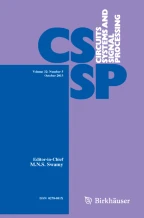Abstract
In order to eliminate the effect of noise on the performance of the direction-of-arrival (DOA) estimation and reduce the computational complexity, a sparse representation (SR) DOA estimation method is proposed. The proposed method first utilizes the beamspace and element-space covariance differencing to eliminate noise. Afterward, it vectorizes the difference covariance matrix. In a sequence, it establishes a new SR model to complete DOA estimation. Compared to existing SR DOA estimation methods, the proposed method significantly reduces the computational complexity since the parameters to be solved in its SR cost function are regardless of the number of sources and the number of array elements. Simulation results show that in the case of the unknown number of sources and low signal-to-noise ratios (SNRs), the proposed method has high DOA resolution and estimation accuracy.
Similar content being viewed by others
Data Availability
Data will be available on request from the authors.
References
A. Bental, A. Nemirovski, Lectures on modern convex optimization: analysis, algorithms, and engineering applications. Society for Industrial and Applied Mathematics. (2001)
Y.F. Fang, H.Y. Wang, S.Q. Zhu, Reconstructing DOA estimation in the second-order statistic domain by exploiting matrix completion. Circ. Syst. Sig. Proc. 38, 1–19 (2019)
A.B. Gershman, Direction finding using beamspace root estimator banks. IEEE Trans. Sig. Proc. 46, 3131–3135 (1998)
Z.Q. He, Q.H. Liu, L.N. Jin, Low complexity method for DOA estimation using array covariance matrix sparse representation. Elect. Lett. 49(3), 228–229 (2013)
Z.Q. He, Z.P. Shi, L. Huang, Covariance sparsity-aware DOA estimation for nonuniform noise. Dig. Sig. Proc. 28, 75–81 (2014)
X. Jing, X. Liu, H. Liu, A sparse recovery method for DOA estimation based on the sample covariance vectors. Circ. Syst. Sig. Proc. 36(3), 1066–1084 (2017)
G.L. Liang, K. Tao, Z. Fan, Adaptive beam space transformation generalized likelihood ratio test algorithm using acoustic vector sensor array. Acta Electonica Sinica. 43(1), 135–139 (2015)
A.F. Liu, D.S. Yang, S.G. Shi, Augmented subspace MUSIC method for DOA estimation using acoustic vector sensor array. IET Radar Sonar Nav. 13(6), 075–969 (2019)
D. Malioutov, M. Cetin, A sparse signal reconstruction perspective for source localization with sensor arrays. 53(8), 3010-3022 (2005)
Y. Nesterov, A. Nemirovskii, Interior-point polynomial algorithms in convex programing. SIAM Studies in Applied Mathematics. 13(1994)
A. Paulraj, T. Kailath, Eigenstructure methods for direction of arrival estimation in the presence of unknown noise fields. IEEE Trans. Acoust. Speech Signal Proc. 34(1), 13–20 (1986)
S. Prasad, R.T. Williams, A.K. Mahalanabis, A transform-based covariance differencing approach for some classes of parameter estimation problems. IEEE Trans. Acoust. Speech Signal Proc. 36, 631-641 (1988)
R. Roy, T. Kailath, ESPRIT-estimation of signal parameters via rotational invariance techniques. IEEE Trans. Acoust. Speech Signal Proc. 37(7), 984–995 (2002)
R.O. Schmidt, Multiple emitter location and signal parameter estimation. IEEE Trans. Antennas Propag. 34(3), 276–280 (1986)
P. Stoica, P. Babu, J. Li, SPICE: a sparse covariance-based estimation method for array processing. IEEE Trans. Signal Process. 59(2), 629–638 (2011)
P. Stoica, P. Babu, SPICE and LIKES: Two hyperparameter-free methods for sparse-parameter estimation. Signal Proc. 92(7), 1580–1590 (2012)
S.G. Shi, Y. Li, D.S. Yang, DOA estimation of coherent signals based on the sparse representation for acoustic vector-sensor arrays. Circ. Syst. Signal Proc. 39(7), 3553–3573 (2020)
F. Tuteur, Y. Rockah, A new method for signal detection and estimation using the eigenstructure of the covariance difference. IEEE International Conference on Acoustics, Speech, and Signal Processing. (2811-2814)(1986)
J. Yin, T. Chen, Direction-of-arrival estimation using a sparse representation of array covariance vectors. IEEE Trans. Signal Proc. 59(9), 4489–4493 (2011)
T. Ye, X.Y. Sun, Y.D. Qin, DOA estimation in unknown colored noise using covariance differencing and sparse signal recovery. J. China Univ. Posts Telecommun. 21(3), 106–112 (2014)
Acknowledgements
This research was supported by the National Natural Science Foundation of China (Grant No. 61701133).
Author information
Authors and Affiliations
Corresponding author
Ethics declarations
Conflict of interest
The authors declare that they have no conflict of interest.
Ethical Approval
This article does not contain any studies with human participants or animals performed by any of the authors.
Additional information
Publisher's Note
Springer Nature remains neutral with regard to jurisdictional claims in published maps and institutional affiliations.
Rights and permissions
About this article
Cite this article
Xu, F., Liu, A., Shi, S. et al. DOA Estimation Using Sparse Representation of Beamspace and Element-Space Covariance Differencing. Circuits Syst Signal Process 41, 1596–1608 (2022). https://doi.org/10.1007/s00034-021-01846-y
Received:
Revised:
Accepted:
Published:
Issue Date:
DOI: https://doi.org/10.1007/s00034-021-01846-y
